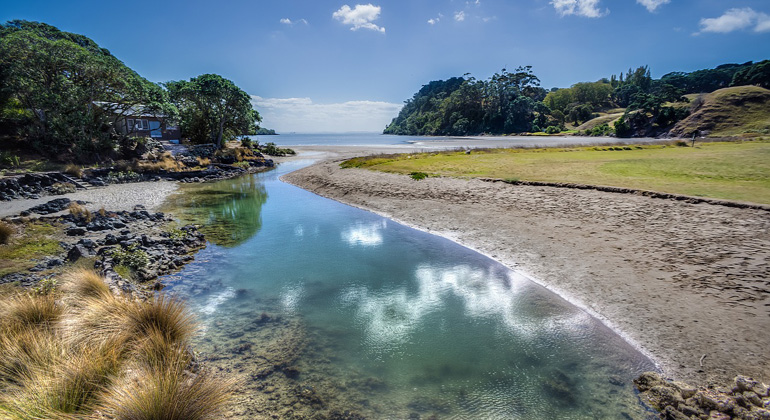Second report on the status of global water resources published
The World Meteorological Organization (WMO) recently presented its second report on the status of global water resources. According to this report, large parts of the world experienced drier conditions in 2022 than those recorded on average for the equivalent periods over the last 30 years.
“Nearly 40 percent of the territories examined were suffering from drier than normal conditions,” said Professor Robert Reinecke of Johannes Gutenberg University Mainz (JGU). “This means that the flow rate of many rivers worldwide was significantly below what would normally be expected. Added to this, the levels of moisture in the soil were frequently indicative of the effects of the heatwaves we have experienced while the need for greater use of water has resulted in the groundwater table becoming lower than in the reference period.” Reinecke, who joined the JGU Institute of Geography in May 2023, has made a major contribution to the new WMO report – in collaboration with Dr. Hannes Müller Schmied of Goethe University Frankfurt and the Senckenberg Leibniz Biodiversity and Climate Research Center Frankfurt (SBiK-F) as well as the Global Runoff Database Center (GRDC) in Koblenz. Together they supplied simulation data based on hydrological modeling, participated in the development of the corresponding methodology, and provided scientific validation of the report’s key statements. With the WMO acting as coordinating body, the report results from the expertise provided by 11 international modeling groups.
Scientifically validated findings on the global water situation
The first State of Global Water Resources Report for 2021 was presented in late November 2022 at the WMO headquarters in Geneva. The report is to appear annually and provide an overview of the status of the Earth’s water resources. The effects of climatic fluctuations and changes can often also be seen by what happens to our water: Heatwaves coupled with droughts can make wildfires more likely and these can then spread more rapidly due to the lack of soil moisture, to give only one example. “The WMO report is thus also designed to provide politicians and the industry with knowledge so as to identify regions that are at risk of experiencing water emergencies or are already in crisis,” added Reinecke.
Among the data shown in the 2022 report is information on the discharge rate of rivers, the levels of groundwater, soil moisture, and evaporation. However, generation of the data basis itself is problematic in that there are currently insufficient global statistics available. “Thus, we need to undertake simulation modeling,” explained Reinecke, a specialist in modeling techniques. There is a particular lack of data on the situation regarding groundwater. Even Germany cannot provide complete figures as to the related circumstances. However, there is no doubt that the dry conditions in 2022 had considerable impact in Germany, too. Just as in the case of the River Po in Italy, the water levels of the Rhine fell dramatically over longer periods, with the associated consequences for river traffic. France suffered from insufficient precipitation, resulting in difficulties when it came to providing the cooling required by nuclear power plants. South America experienced severe drought conditions while, despite increasing precipitation, groundwater levels in the important Murray-Darling Basin in Australia continued to drop below normal.
New Earth System Modeling group at Mainz University
Robert Reinecke was appointed to a junior professorship at JGU’s Institute of Geography in May 2023. Here he will establish an Earth System Modeling group. After studying computer science at TU Darmstadt, being awarded a doctorate by Goethe University Frankfurt, and undertaking research in California, he was employed at the International Center for Water Resources and Global Change (ICWRGC). He subsequently undertook research as a postdoc at the Institute of Environmental Science and Geography of the University of Potsdam. His research focuses on global groundwater in the context of global hydrological modeling. He also investigates surface water/groundwater interaction, the human impact on groundwater resources, and the impact of climate change on the hydrological cycle.

Cooperative project within the Rhine-Main Universities Alliance
The research project was a joint effort of the Rhine-Main Universities (RMU), a strategic alliance consisting of Goethe University Frankfurt, Johannes Gutenberg University Mainz, and TU Darmstadt – three prestigious, research-led universities. The RMU framework agreement, signed in December 2015, extended the long-standing partnership and made the collaboration into a strategic alliance designed to promote the research undertaken by the universities, improve the shared courses on offer, and enhance knowledge transfer and networking with society in general.
Related links
- Earth System Modeling group at the JGU Institute of Geography
- 2022 State of Global Water Resources report of the World Meteorological Organization (WMO)
- Global Runoff Data Centre (GRDC)
- International Centre for Water Resources and Global Change (ICWRGC)
Source
Johannes Gutenberg Universität Mainz 2023 | Weltorganisation für Meteorologie (WMO), State of Global Water Resources 2022








